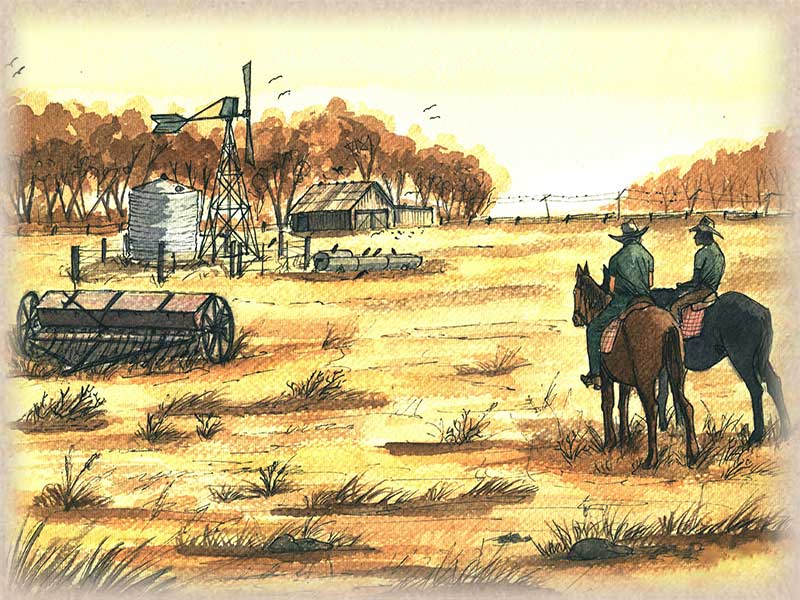
Australia
Us Aussies > Let's Visit Australia > Convicts to ConscriptsAustralia Confronting the Future > Australia and the Implications of Multiculturalism
Let's Visit Australia
(Published in Great Britain, by Burke Publishing Company Limited, 1983)
[John C. Caldwell]
Let's Visit Australia
7
The continent of Australia lies entirely south of the equator. Because of its position on the globe, Australia is often called the Land Down Under. There are many unusual facts about this country.
It is one of the world's largest in area but among the smallest in population, and four-fifths of this population are crowded into a few cities. It is the only country to occupy a whole continent. Australia is the smallest continent in area, but it is the oldest.
Because of its age, Australia has animals and birds found nowhere else in the world. The continent became separated from the other land masses of the earth millions of years ago. Some varieties of birds and animals developed after Australia's formation as a separated continent.
Because of its age, Australia has animals and birds found nowhere else in the world. The continent became separated from the other land masses of the earth millions of years ago. Some varieties of birds and animals developed after Australia's formation as a separated continent.
Australia is the home of the kangaroo - or , rather, kangaroos. There are about forty different members of this group of animals. The kangaroos are found only in Australia (except for tree-climbing species, found also in New Guinea). There are some very small members of this family, but the "big red" and
8
the "great grey" kangaroos may stand higher than a man. Kangaroos are members of an ancient group of animals known as the marsupials. This word comes from a Latin word meaning "pouch". Members of this mammal family carry their young in a pouch.
9
... Australia was the last continent to be discovered by
10
Europeans and the last to be settled by them. Because of its geological age, it has varieties of animals and birds that have either long since disappeared or never developed on other parts of the earth.
... Australia is the only country in the world to occupy an entire continent. It is the one of the few countries which, instead of being overcrowded, had sought new citizens to fill its great empty spaces
The Land Down Under
12
The fact that Australia lies south of the equator tells us something else about its weather and climate. In all parts of the world south of the equator, seasons are the reverse of those north of the equator.
14
There are great areas of sand, rock and clay. Here and there are trees, but for the most part the vegetation consists of bushes that can grow with very little water. Australians call this part of their country the Never-Never.
There are places in the middle of the continent where rivers flow inland instead of toward the sea.
There are large areas without water, yet underground there may be huge natural stores known as artesian
15
basins. In fact, many sheep - and cattle-grazing areas rely heavily on such water, which is brought to the surface by windmill and stored tanks.
18
There are two other interesting features of Australia's geography. First, let's mention the fine ocean beaches. Along the east and parts of the south and west coasts are hundreds of beaches.
The surf is unusually high, and surfboarding has become one of Australia's important sports. The coast of Queensland, in eastern Australia, is famous as a winter holiday region
19
because of its sunshine and mild climate. The most popular part is the Gold Coast, near Brisbane.
The second unusual geographic feature is also found along the east and north-east coast. The largest coral reef in the world extends from north of Brisbane all the way to New Guinea
Called the Great Barrier Reef, it extends for 1,250 miles (2,000km) and covers 80,000 square miles (about 200,000 square kilometres).
There are numerous beautiful tropical islands scattered along the reef, or between the reef and the mainland. There are coral gardens, filled with beautifully coloured tropical fish, strange green sea turtles and very big sharks.
Coral reefs are found throughout the South Pacific. Coral is formed form the dead bodies of tiny sea creatures called polyps. The combined skeletons of millions of polyps are deposited on the bottom of the ocean and slowly build upward.
20
until the coral reaches the surface. A coral reef may be quite close to the shore or a long distance away from it. It protects the coast from the force of the ocean waves.
This makes the water between the reef and the shore calm. The calm waters inside the reef are clear, and it is possible to look down and see tropical fish and other creatures clearly.
The Murray River and its tributaries form one of the longest river systems in the world, but the Murray river itself is the only one which is navigable for any great distance The Murray-Murrumbidgee-Darling system drains the south-eastern part of Australia and flows into the Great Australian Bight near Adelaide.
22
Finally, let's mention Australia's overseas territories. Until recently, the best-known of these territories was Papua New Guinea,
a country occupying the eastern half of the huge island 150 miles (240 kilometres) north of Australia. However, Papua New Guinea is no longer an Australian territory.
Though it still receives a good deal of Australian help, it is now fully independent, self-governing country, and a member of the United Nations Organisation.
During World War II great naval battles and bitter jungle fighting took place in Papua New Guinea and the Solomon Islands. The defeat of Japanese in this area was a turning
23
point in the war and perhaps saved Australia from invasion.

